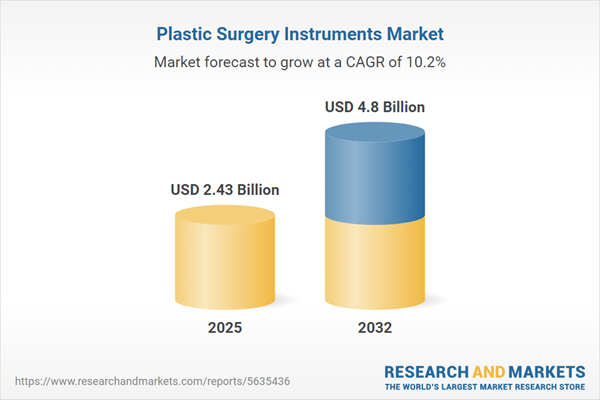Speak directly to the analyst to clarify any post sales queries you may have.
Senior decision-makers in the plastic surgery instruments market face a dynamic environment, shaped by new regulatory requirements, technological advancements, and expanding sustainability standards. Navigating this evolving landscape calls for strategic foresight and operational agility to preserve leadership and capitalize on emerging opportunities.
Market Snapshot: Plastic Surgery Instruments Market Growth and Outlook
The plastic surgery instruments market is poised for substantial expansion through 2032, fueled by heightened demand for both minimally invasive and complex reconstructive procedures. This growth reflects greater awareness around aesthetic outcomes and patient safety, as well as rapid advances in surgical techniques and procedures. A broad array of instrumentation underscores the importance of procurement agility and innovation as the healthcare ecosystem shifts. For executives, anticipating shifts in institutional requirements and regulatory landscapes is now essential. Those able to innovate promptly and address sustainability will enhance organizational resilience and benefit from new clinical opportunities.
Scope & Segmentation of the Plastic Surgery Instruments Market
This strategic report is crafted for C-level executives tasked with overseeing procurement, integrating clinical technologies, and shaping operational policy in the plastic surgery instruments sector. Analysis provides segmentation for focused leadership decisions, ensuring organizations meet current regulatory and innovation benchmarks across diverse business units.
- Instrument Types: Drill systems, endoscopes, forceps, retractors, scalpels, and scissors are crucial for both aesthetic and reconstructive care. Their precise selection is vital for surgical accuracy and effective workflows.
- Applications: Tools are designed for uses such as burn care, wound debridement, skin grafting, and cosmetic procedures, ensuring versatility across multiple care protocols and clinical methodologies.
- End Users: Adoption rates vary between ambulatory surgical centers, specialty practices, hospitals (public and private), and general clinics, each with unique procurement considerations and regulatory demands shaping acquisition patterns.
- Material Types: Core materials include plastics, stainless steel, and titanium, with key selection criteria centered on sterility, biocompatibility, and lifecycle durability. These factors align with both immediate performance goals and long-term sustainability mandates.
- Sales Channels: Purchasing channels consist of direct hospital relationships, broad distributor networks, and increasingly, digital procurement platforms, allowing for enhanced agility and responsiveness amid shifting supply chain conditions.
- Regions Analyzed: Evaluation extends to the Americas, Europe, Asia-Pacific, and the Middle East & Africa, reflecting the diversity of clinical standards, partnership models, and regulatory frameworks influencing instrument adoption worldwide.
- Leading Players Studied: Major manufacturers analyzed are Johnson & Johnson, Medtronic plc, B. Braun Melsungen AG, Stryker Corporation, Smith & Nephew plc, Zimmer Biomet Holdings, ConMed Corporation, Integra LifeSciences Holdings Corporation, KARL STORZ SE & Co. KG, and Teleflex Incorporated, all shaping innovation and competitive dynamics.
Key Takeaways for Senior Decision-Makers
- Expanding use of robotics, artificial intelligence, and advanced imaging has enhanced clinical capabilities and improved patient outcomes across the plastic surgery instruments market segment.
- Ongoing evolution of material selection and process engineering strengthens sustainability and compliance, aligning procurement with regulatory and environmental priorities.
- Investment in local sourcing and additive manufacturing capabilities helps build a more resilient supply chain, safeguarding operations during periods of market disruption and volatility.
- Strategic partnerships between device manufacturers and healthcare organizations are reducing product development times and streamlining the introduction of new technologies in clinical settings.
- Adoption of customizable instruments and rapid prototyping increases responsiveness to specific clinical needs, offering differentiation and increased value amid competitive pressures.
Market Tariff Impact: Navigating Trade and Supply Chain Shifts
Shifts in U.S. tariffs have driven many organizations to adopt nearshore manufacturing strategies and reinforce domestic supplier relationships. By moving toward just-in-time inventory models and investing in on-site additive manufacturing, healthcare institutions are mitigating risks associated with global supply chain disruptions. These strategies ensure continuity of access to critical instruments, supporting operational effectiveness even when faced with external fluctuations.
Methodology & Data Sources
Findings in this report are backed by direct interviews with surgeons, procurement leaders, and regulatory officials. The insights have been vetted through industry documents and third-party expert reviews to offer reliable, decision-focused intelligence.
Why This Report Matters
- Provides senior executives with actionable insights to refine procurement, guide technology integration, and ensure investments align with evolving regulations and market trends.
- Delivers practical analysis on sustainability initiatives, best-practice supply chain strategies, and clinical innovation, supporting operational adaptability.
- Enables rapid, informed responses to sector developments for ongoing resilience in the plastic surgery instrument industry.
Conclusion
With current intelligence and comprehensive segmentation, senior leaders can confidently align operational, regulatory, and technology initiatives, ensuring agility and continuity as the plastic surgery instruments market continues to evolve.
Additional Product Information:
- Purchase of this report includes 1 year online access with quarterly updates.
- This report can be updated on request. Please contact our Customer Experience team using the Ask a Question widget on our website.
Table of Contents
3. Executive Summary
4. Market Overview
7. Cumulative Impact of Artificial Intelligence 2025
Companies Mentioned
The companies profiled in this Plastic Surgery Instruments market report include:- Johnson & Johnson
- Medtronic plc
- B. Braun Melsungen AG
- Stryker Corporation
- Smith & Nephew plc
- Zimmer Biomet Holdings, Inc.
- ConMed Corporation
- Integra LifeSciences Holdings Corporation
- KARL STORZ SE & Co. KG
- Teleflex Incorporated
Table Information
| Report Attribute | Details |
|---|---|
| No. of Pages | 190 |
| Published | October 2025 |
| Forecast Period | 2025 - 2032 |
| Estimated Market Value ( USD | $ 2.43 Billion |
| Forecasted Market Value ( USD | $ 4.8 Billion |
| Compound Annual Growth Rate | 10.2% |
| Regions Covered | Global |
| No. of Companies Mentioned | 11 |









